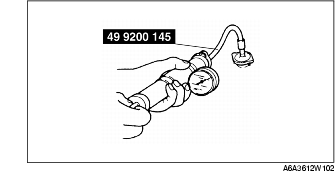ENGINE COOLANT LEAKAGE INSPECTION [ZY]
id0112008005a5
-
Warning
-
• Never remove the radiator cap while the engine is running, or when the engine and radiator are hot. Scalding engine coolant and steam may shoot out and cause serious injury. It may also damage the engine and cooling system.
-
• Turn off the engine and wait until it is cool. Even then, be very careful when removing the cap. Wrap a thick cloth around it and slowly turn it counterclockwise to the first stop. Step back while the pressure escapes.
-
• When you are sure all the pressure is gone, press down on the cap using the cloth, turn it, and remove it.
-
Caution
-
• Applying more than 127 kPa {1.3 kgf/cm2, 18.4 psi} can damage the hoses, fittings, and other components, and cause leaks.
1. Inspect the engine coolant level.
2. Remove the radiator cap.
3. Clean the mounting surface of the radiator cap and the upper radiator hose.
4. Connect a radiator cap tester and the SST to the reservoir filler port.
5. Apply specified pressure to the radiator using a radiator cap tester.
Pressure
-
122.6 kPa {1.25 kgf/cm2, 17.8 psi} [1 min]
6. When pressurizing the radiator, verify that the pressure is maintained.
-
• If not, inspect the system for engine coolant leakage.
-
- If the engine coolant leaks from the upper hose attachment part, replace the upper hose and the clamp.
-
- If the engine coolant leaks from the main body of the radiator (caulked part), replace the radiator.
